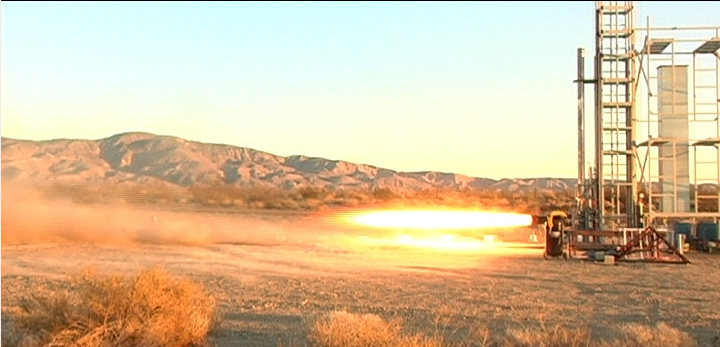
[SatNews] An incandescent 24-foot beam of fire thundered from the engine’s ablative combustion chamber, generating 7,500-lbs of thrust.
At dawn on October 21, 2013, Interorbital Systems conducted a short-burn flight qualification run of its main rocket engine in a spectacular hot-firing at the Mojave Spaceport. An incandescent 24-foot beam of fire thundered from the engine’s ablative combustion chamber, generating 7,500-lbs of thrust.
The test verified several new software systems including automated launch control and launch system health reporting. In addition, the test verified the combustion stability of the engine's secondary hypergolic liquid ignition propellant in an extended igniter burn phase. The video of the test shows a smooth transition from the secondary hypergolic fuel to the primary fuel, turpentine, with a corresponding increase in the brilliance of the plume.

The rocket engine's unique injector and combustion chamber architecture yielded a specific impulse (Isp) averaging 245 seconds at sea level ambient pressure, which equates to a 305-second vacuum specific impulse. The high density of the concentrated white fuming nitric acid and turpentine propellant combination produced a density specific impulse at sea level of 323 seconds. High density specific impulse substantially reduces the weight of a rocket's propellant tanks which leads to an overall reduction in the total rocket weight and a corresponding increase in payload weight.
All things considered, the overall performance of these propellants in Interorbital's propulsion system is equal to the performance of liquid oxygen and kerosene—without the logistical problems associated with the use of super-cold cryogenic liquid oxygen, like the need for insulated trucks and storage tanks; expensive processing infrastructure; and constant mitigation procedures to combat evaporation and freezing issues. In contrast, the Nitric Acid oxidizer can be stored and transported in simple aluminum containers and held in a rocket propellant tank for several years. The test also verified the performance of Interorbital's new all-composite ablative combustion chamber which performed perfectly, showing only minor erosion after the test despite an average temperature in the combustion chamber of 5,400 degrees Fahrenheit.
This hot-firing completes the testing of all systems required for the upcoming low-altitude launch of the Common Propulsion Module Test Vehicle (CPM-TV). The CPM-TV is a boiler plate version of Interorbital's Common Propulsion Module (CPM). The CPM-TV will carry a mixed manifest of four payloads: CubeSats from Dragonfly Astro (CA) and Boreal Space (CA)/Datora Telecom, Brazil (an M2M gateway/proxy prototype); and TubeSats from Morehead State University/Kentucky Space and from the Naval Postgraduate School (CA) (an ad hoc communication node experiment). All satellites on-board the first suborbital launch are constructed from Interorbital’s line of small satellite kits. Interorbital has sold out its first two orbital missions with over 60 small sats on the launch manifest for 2014; bookings continue for Mission III.

